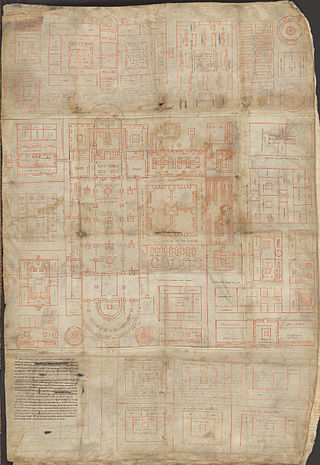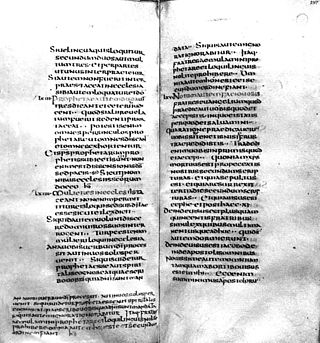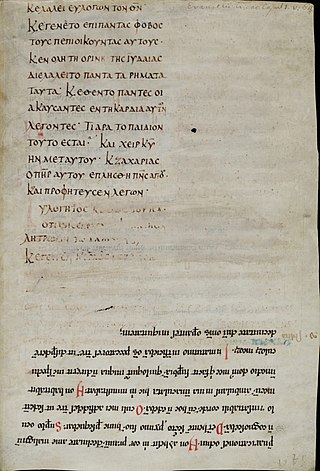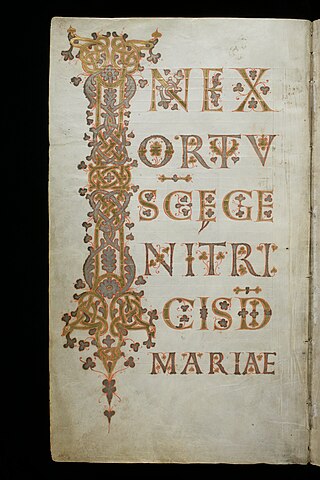
The Abbey of Saint Gall is a dissolved abbey (747–1805) in a Catholic religious complex in the city of St. Gallen in Switzerland. The Carolingian-era monastery existed from 719, founded by Saint Othmar on the spot where Saint Gall had erected his hermitage. It became an independent principality between 9th and 13th centuries, and was for many centuries one of the chief Benedictine abbeys in Europe. The library of the Abbey is one of the oldest monastic libraries in the world.

The Irish Gospels of St. Gall or Codex Sangallensis 51 is an 8th-century Insular Gospel Book, written either in Ireland or by Irish monks in the Abbey of St. Gall in Switzerland, where it is now in the Abbey library of St. Gallen as MS 51. It has 134 folios. Amongst its eleven illustrated pages are a Crucifixion, a Last Judgement, a Chi Rho monogram page, a carpet page, and Evangelist portraits.

Abrogans, also German Abrogans or Codex Abrogans, is a Middle Latin–Old High German glossary, whose preserved copy in the Abbey Library of St Gall is regarded as the oldest preserved book in the German language.

The Plan of Saint Gall is a medieval architectural drawing of a monastic compound dating from 820–830 AD. It depicts an entire Benedictine monastic compound, including churches, houses, stables, kitchens, workshops, brewery, infirmary, and a special house for bloodletting. According to calculations based on the manuscript's tituli the complex was meant to house about 110 monks, 115 lay visitors, and 150 craftmen and agricultural workers. The Plan was never actually built, and was so named because it is dedicated to Gozbert abbot of Saint Gall. The planned church was intended to keep the relics of Saint Gall. The plan was kept at the famous medieval monastery library of the Abbey of St. Gall, the Stiftsbibliothek Sankt Gallen where it remains to this day.

The Folchart Psalter, or Folchard Psalter, is a Carolingian illuminated manuscript. It was produced about 872–883 in the scriptorium of the Abbey of St. Gall, Switzerland, under the direction of the scribe Folchardus, usually modernized as Folchard or Folchart.

Saint Randoald was prior of the Benedictine Moutier-Grandval Abbey under Germanus of Granfelden. He is recognised as a saint in the Catholic and Eastern Orthodox Churches

The Codex Fuldensis, also known as the Victor Codex, designated by F, is a New Testament manuscript based on the Latin Vulgate made between 541 and 546. The codex is considered the second most important witness to the Vulgate text; and is also the oldest complete manuscript witness to the order of the Diatessaron. It is an important witness in any discussion about the authenticity of 1 Corinthians 14:34–35 and the Comma Johanneum. It is one of the earliest dated manuscripts of the New Testament. It was corrected until 2 May, 546 AD.

Saint Germanus of Granfelden was the first abbot of Moutier-Grandval Abbey. He is venerated as a martyr saint in the Catholic and Eastern Orthodox Churches.

Uncial 0130, ε 80 (Soden), is a Greek uncial manuscript of the New Testament, dated palaeographically to the 9th-century. Formerly it was labelled by Wc.
Codex Sangallensis is the designation of codices housed at the Abbey library of Saint Gall in St. Gallen. The codices are index with a continuous arabic number, many of the codices have been digitized through the e-codices project in Switzerland with over 2000 of them freely available online.

Codex Sangallensis 1395 is a nineteenth-century compilation of fragments, and includes a 5th-century Latin manuscript of the New Testament, designated by Σ. The text, written on vellum, is a version of the Latin Vulgate.

The Codex Sangallensis 63, designated by S in some critical editions of the Bible, is a 9th-century Latin manuscript of the New Testament. The text, written on vellum, is a version of the Vulgate and contains the text of the Acts of the Apostles, Epistles, Book of Revelation, and non-biblical material. The manuscript has not survived in a complete condition, some parts of it have been lost. The original manuscript did not contain the Comma Johanneum, but it was added by a later hand on the margin.

The Codex Sangallensis 907, designated S, is an 8th-century Latin manuscript of the New Testament. The text, written on vellum, is a version of the Latin Vulgate Bible. It contains the text of the Catholic epistles, Book of Revelation, and non-biblical material. The manuscript did not survived in a complete condition and some parts of it has been lost. The codex contains the Comma Johanneum.

The Golden Psalter of St. Gall is a Carolingian Gallican psalter produced in the late 9th century, probably begun in West Francia, later continued in St. Gall Abbey.

Fragmentarium is an online database to collect and collate fragments of medieval manuscripts making them available to researchers, collectors and historians worldwide. It is an international collaboration of major libraries and collections including the British Library, Bibliothèque nationale de France, Martin Schøyen Collection, Bavarian State Library, Harvard, Yale and the Vatican. It is based in Switzerland and the project's current director is Professor Christoph Flüeler from the University of Fribourg and the Virtual Manuscript Library, Switzerland.

The Evangelium longum is an illuminated manuscript Latin evangeliary that was made around 894 at the Abbey of Saint Gall in Switzerland. It consists of texts drawn from the Gospels for the use of the preacher during Mass.
The St. Gall Priscian Glosses, abbreviated Sg., is an Irish manuscript of the Latin grammar Institutiones grammaticae by Priscian, held by the Abbey Library of St. Gall. It contains 9412 glosses, including 3478 in Old Irish. Together with the Würzburg glosses on the Epistles of St Paul and the Milan glosses on a Commentary on the Psalms they provide the main source of Old Irish writing available today and thus serve as an important reference for linguistic research on Old Irish.

Shep-en-Isis, or Schepenese, was the daughter of Pa-es-tjenfi, a priest, and Tabes, of Thebes, Egypt; she was likely literate during her life and it is unknown who her husband was and it is also unknown if she had any children. Her mummified body is notable as her facial reconstruction was completed by forensic scientists in January 2022 and she is also one of the most famous mummies in Switzerland.

The Codex Sangallensis 484 is an early medieval music manuscript, produced in the abbey of St. Gallen and stored in the Abbey Library in St. Gallen. The manuscript is known for its exhaustive collection of so-called tropes, meaning melodic or textual extensions to previously existing liturgic chants. As this particular manuscript is among the most extensive collections of such tropes from the eastern Frankish kingdom, it plays an important role in the history of music.

The Codex Sangallensis 381 is an early medieval music manuscript, produced in the abbey of St. Gallen and stored in the Abbey Library in St. Gallen. The manuscript is known for its exhaustive collection of so-called tropes, verses, and sequences. Together with the Cod. Sang. 484, this manuscript makes an important contribution to one of the most exhaustive collections of such compositions in the East Frankish kingdom and thus plays an important role in the history of music.





















